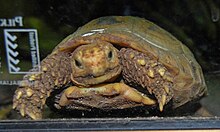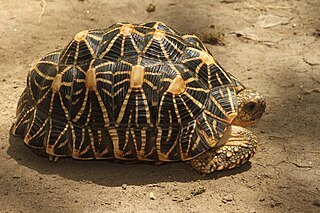
The Indian star tortoise is a threatened tortoise species native to India, Pakistan and Sri Lanka where it inhabits dry areas and scrub forest. It has been listed as Vulnerable on the IUCN Red List since 2016, as the population is thought to comprise more than 10,000 individuals, but with a declining trend. It is threatened by habitat loss and poaching for the illegal wildlife trade. It was upgraded to CITES Appendix I in 2019 by full consensus among all member states, giving it the highest level of international protection from commercial trade. Conservation group TRAFFIC found 6,040 were seized globally that were intended to be sold in the pet trade.

Boiga trigonata, commonly known as the Indian gamma snake or common cat snake, is a species of rear-fanged colubrid endemic to South Asia.

The trinket snake, also known commonly as the common trinket snake, is a species of nonvenomous constricting snake in the family Colubridae. The species is native to southern Central Asia.

Forsten's tortoise, also known commonly as the Sulawesi tortoise, is a species of tortoise in the family Testudinidae. The species is native to Sulawesi Island, Indonesia.

The Asian forest tortoise, also known commonly as the Mountain tortoise or Burmese Brown Mountain tortoise, is a species of tortoise in the family Testudinidae. The species is endemic to Southeast Asia. It is believed to be among the most primitive of living tortoises, based on molecular and morphological studies.
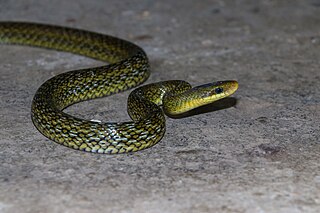
Elaphe hodgsoni, also known commonly as Hodgson's rat snake and the Himalayan trinket snake, is a species of snake in the family Colubridae. The species is native to parts of Asia around the Himalayas.

Lycodon aulicus, commonly known as the Indian wolf snake or common wolf snake, is a species of nonvenomous snake found in South Asia and Southeast Asia. Early naturalists have suggested its resemblance to the venomous common krait as an instance of Batesian mimicry.
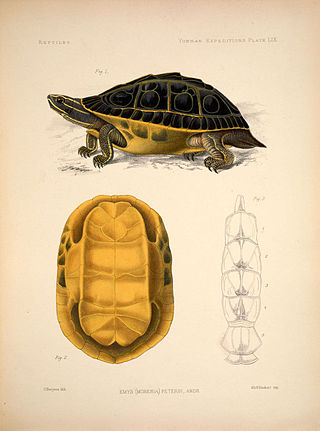
The Indian eyed turtle is a species of turtle in the family Geoemydidae. The species is endemic to South Asia.
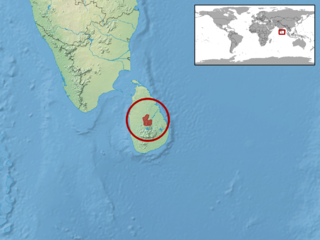
The Kandyan day gecko or Kandyan rock gecko is a species of diurnal gecko found in Sri Lanka.

Ophisops jerdonii, commonly known as Jerdon's cabrita, Jerdon's snake-eye, or Punjab snake-eyed lacerta, is a species of lacertid lizard, which is distributed in east Afghanistan, Pakistan, and India.

The black pond turtle, also known commonly as the spotted pond turtle and the Indian spotted turtle, is a species of freshwater turtle in the family Geoemydidae. The species, which is endemic to South Asia, belongs to the monotypic genus Geoclemys.

The Cochin forest cane turtle, also known as Kavalai forest turtle, forest cane turtle or simply cane turtle, is a rare turtle from the Western Ghats of India. Described in 1912, its type locality is given as "Near Kavalai in the Cochin State Forests, inhabiting dense forest, at an elevation of about 1500 feet above sea level". Only two specimens were found at that time, and no scientist saw this turtle for the next 70 years. It was rediscovered in 1982, and since then a number of specimens have been found and some studies have been conducted about its phylogeny and ecology.

The red-crowned roofed turtle or Bengal roof turtle is a species of freshwater turtle endemic to South Asia. It was the type species of its former genus Kachuga. Females can grow to a shell length of 56 cm (22 in) and weigh 25 kilograms (55 lb), but males are considerably smaller. The turtles like to bask in the sun on land. In the breeding season, the heads and necks of male turtles exhibit bright red, yellow and blue coloration. The females excavate nests in which they lay clutches of up to thirty eggs.

The brown roofed turtle is a species of turtle in the family Geoemydidae. The species is endemic to South Asia. Two subspecies are recognized.

The Indian roofed turtle is a species of turtle in the family Geoemydidae. It can be distinguished by the distinct "roof" at the topmost part of the shell. It is found in the major rivers of South Asia. It is a common pet in the Indian Subcontinent.

The big-headed pantanal swamp turtle or pantanal swamp turtle is a species of turtle in the family Chelidae found in Brazil, Bolivia, Argentina, and Paraguay.
Dahl's toad-headed turtle is a medium-sized species of side-necked turtle in the family Chelidae. This critically endangered freshwater turtle is endemic to northern Colombia, where it lives in small pools, streams, and swamps, but aestivates on land.
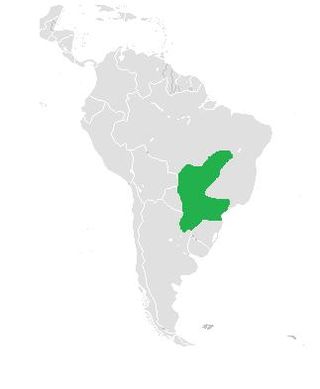
Vanderhaege's toad-headed turtle is a species of turtle in the family Chelidae. The species is endemic to South America.

The turtle shell is a shield for the ventral and dorsal parts of turtles, completely enclosing all the vital organs of the turtle and in some cases even the head. It is constructed of modified bony elements such as the ribs, parts of the pelvis and other bones found in most reptiles. The bone of the shell consists of both skeletal and dermal bone, showing that the complete enclosure of the shell likely evolved by including dermal armor into the rib cage.

Basilemys is a large, terrestrial nanhsiungchelyid turtle from the Upper Cretaceous of North and Central America. Basilemys has been found in rocks dating to the Campanian and Maastrichtian subdivisions of the Late Cretaceous and is considered to be the largest terrestrial turtle of its time. In an analysis made by Sukhanov et al. on a nansiunghelyid turtle from the Upper Cretaceous of Mongolia, it was demonstrated that Asian nanhsiungchelyids gave rise to the North American nanhsiungchelyids.


